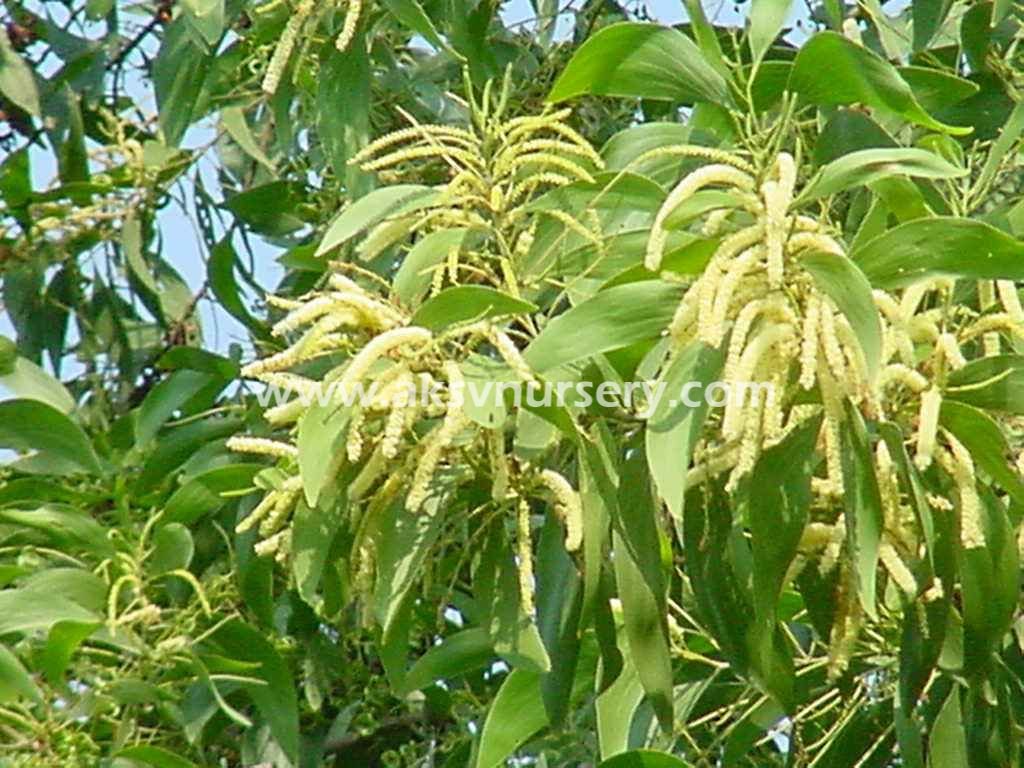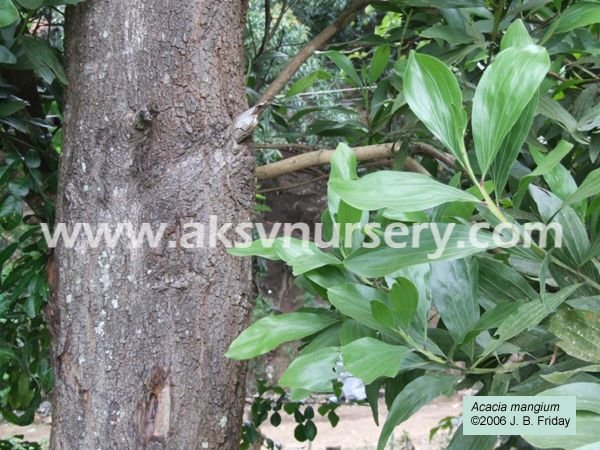Acacia mangium
Family: Mimosoideae / Mimosaceae
Mangium Wattle, Black Wattle, Hickory Wattle
Acacia mangium is a single-stemmed evergreen tree or shrub that grows to 25-35 m in height. Young trees have smooth, greenish bark; fissures begin to develop at 2-3 years. Bark in older trees is rough, hard, fissured near the base, greyish-brown to dark brown, inner bark pale brown. Bole in older trees branchless for up to 15 m, fluted, up to 90 cm in diameter; branchlets acutely triangular. Phyllodes are large up to 25 cm long and 3.5-10 cm broad, 2-5 times as long as wide, straight or straight along 1 side and curved along the other, with 4 (max. 5) main longitudinal veins, secondary veins finely anastomosing; glaborous, pulvinus 6-10 cm long. A gland (extra floral nectary) is conspicuous at the base of the phyllode. Inflorescence is composed of many tiny white or cream flowers in spikes. Flowers are quinqeufloral; the calyx is 0.6-0.8 mm long, with obtuse lobes; corolla 1.2-1.5 mm long. Peduncles are canescent and pubescent, about 1 cm long; rachis is also canescent and pubescent. Pods are broad, linear and irregularly coiled when ripe. They are membranous or slightly woody, inconspicuously veined. 3-5 mm wide and 7-10 cm long. Ripening pods change from green to brown, stiff and dry. Seeds are black and shiny with shape ranging from longitudinal, elliptical, ovate to oblong, 3-5 mm by 2-3 mm. The seeds are arranged longitudinally and attached to the pods by an orange to red folded funicle. The generic name acacia comes from the Greek word ‘akis’, meaning a point or a barb. This acacia was originally described as Mangium montanum Rumph. in Herbarium Amboinense (1750) but changed to an Acacia in 1806.History of cultivation
A. mangium is planted in the Malesian region, especially in Sabah and Peninsular Malaysia, as an ornamental. Significant areas of plantations have been or are being established in India, Indonesia, Malaysia, Papua New Guinea, Sri Lanka and Thailand. About 50 000 ha of A. mangium plantations have been established in Sabah, and about 42 000 ha in Peninsular Malaysia.
Natural Habitat
A. mangium is a species of the humid, tropical lowland zones. It tolerates pH levels between 4.5 and 6.5. It occurs behind mangroves in seasonal swamps, along streams and on well-drained flats, low ridges and mountain foothills. A. mangium occurs in the Aru Islands, Irian Jaya, Seram, the Sula Islands of Indonesia; Western Province of Papua New Guinea; and northeastern Queensland, Australia. It is sometimes found dominant in primary and secondary forest, forest margin, savannah, grassland, savanna woodland, on poorly drained floodplains and along fringes of mangrove forest, where it is sometimes associated with Melaleuca and Rhizophora species. In Papua New Guinea, it often prefers slightly higher and drier sites than other Acacia species growing in the same area. This species has been successfully planted on abandoned areas of shifting cultivation colonized by Imperata cylindrica grass, but does not tolerate waterlogging and soils derived from ultrabasic rocks.S





